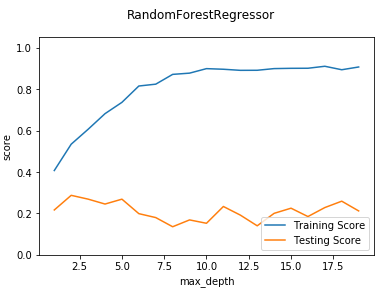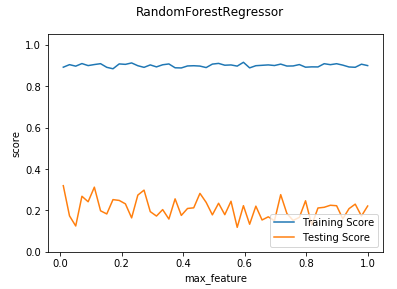吴裕雄 python 机器学习——集成学习随机森林RandomForestRegressor回归模型
import numpy as np
import matplotlib.pyplot as plt from sklearn import datasets,ensemble
from sklearn.model_selection import train_test_split def load_data_regression():
'''
加载用于回归问题的数据集
'''
#使用 scikit-learn 自带的一个糖尿病病人的数据集
diabetes = datasets.load_diabetes()
# 拆分成训练集和测试集,测试集大小为原始数据集大小的 1/4
return train_test_split(diabetes.data,diabetes.target,test_size=0.25,random_state=0) #集成学习随机森林RandomForestRegressor回归模型
def test_RandomForestRegressor(*data):
X_train,X_test,y_train,y_test=data
regr=ensemble.RandomForestRegressor()
regr.fit(X_train,y_train)
print("Traing Score:%f"%regr.score(X_train,y_train))
print("Testing Score:%f"%regr.score(X_test,y_test)) # 获取分类数据
X_train,X_test,y_train,y_test=load_data_regression()
# 调用 test_RandomForestRegressor
test_RandomForestRegressor(X_train,X_test,y_train,y_test)

def test_RandomForestRegressor_num(*data):
'''
测试 RandomForestRegressor 的预测性能随 n_estimators 参数的影响
'''
X_train,X_test,y_train,y_test=data
nums=np.arange(1,100,step=2)
fig=plt.figure()
ax=fig.add_subplot(1,1,1)
testing_scores=[]
training_scores=[]
for num in nums:
regr=ensemble.RandomForestRegressor(n_estimators=num)
regr.fit(X_train,y_train)
training_scores.append(regr.score(X_train,y_train))
testing_scores.append(regr.score(X_test,y_test))
ax.plot(nums,training_scores,label="Training Score")
ax.plot(nums,testing_scores,label="Testing Score")
ax.set_xlabel("estimator num")
ax.set_ylabel("score")
ax.legend(loc="lower right")
ax.set_ylim(-1,1)
plt.suptitle("RandomForestRegressor")
plt.show() # 调用 test_RandomForestRegressor_num
test_RandomForestRegressor_num(X_train,X_test,y_train,y_test)

def test_RandomForestRegressor_max_depth(*data):
'''
测试 RandomForestRegressor 的预测性能随 max_depth 参数的影响
'''
X_train,X_test,y_train,y_test=data
maxdepths=range(1,20)
fig=plt.figure()
ax=fig.add_subplot(1,1,1)
testing_scores=[]
training_scores=[]
for max_depth in maxdepths:
regr=ensemble.RandomForestRegressor(max_depth=max_depth)
regr.fit(X_train,y_train)
training_scores.append(regr.score(X_train,y_train))
testing_scores.append(regr.score(X_test,y_test))
ax.plot(maxdepths,training_scores,label="Training Score")
ax.plot(maxdepths,testing_scores,label="Testing Score")
ax.set_xlabel("max_depth")
ax.set_ylabel("score")
ax.legend(loc="lower right")
ax.set_ylim(0,1.05)
plt.suptitle("RandomForestRegressor")
plt.show() # 调用 test_RandomForestRegressor_max_depth
test_RandomForestRegressor_max_depth(X_train,X_test,y_train,y_test)

def test_RandomForestRegressor_max_features(*data):
'''
测试 RandomForestRegressor 的预测性能随 max_features 参数的影响
'''
X_train,X_test,y_train,y_test=data
max_features=np.linspace(0.01,1.0)
fig=plt.figure()
ax=fig.add_subplot(1,1,1)
testing_scores=[]
training_scores=[]
for max_feature in max_features:
regr=ensemble.RandomForestRegressor(max_features=max_feature)
regr.fit(X_train,y_train)
training_scores.append(regr.score(X_train,y_train))
testing_scores.append(regr.score(X_test,y_test))
ax.plot(max_features,training_scores,label="Training Score")
ax.plot(max_features,testing_scores,label="Testing Score")
ax.set_xlabel("max_feature")
ax.set_ylabel("score")
ax.legend(loc="lower right")
ax.set_ylim(0,1.05)
plt.suptitle("RandomForestRegressor")
plt.show() # 调用 test_RandomForestRegressor_max_features
test_RandomForestRegressor_max_features(X_train,X_test,y_train,y_test)

吴裕雄 python 机器学习——集成学习随机森林RandomForestRegressor回归模型的更多相关文章
- 吴裕雄 python 机器学习——集成学习随机森林RandomForestClassifier分类模型
import numpy as np import matplotlib.pyplot as plt from sklearn import datasets,ensemble from sklear ...
- 吴裕雄 python 机器学习——集成学习梯度提升决策树GradientBoostingRegressor回归模型
import numpy as np import matplotlib.pyplot as plt from sklearn import datasets,ensemble from sklear ...
- 吴裕雄 python 机器学习——集成学习AdaBoost算法回归模型
import numpy as np import matplotlib.pyplot as plt from sklearn import datasets,ensemble from sklear ...
- 吴裕雄 python 机器学习——集成学习AdaBoost算法分类模型
import numpy as np import matplotlib.pyplot as plt from sklearn import datasets,ensemble from sklear ...
- 机器学习:集成学习:随机森林.GBDT
集成学习(Ensemble Learning) 集成学习的思想是将若干个学习器(分类器&回归器)组合之后产生一个新学习器.弱分类器(weak learner)指那些分类准确率只稍微好于随机猜测 ...
- 吴裕雄 python 机器学习——伯努利贝叶斯BernoulliNB模型
import numpy as np import matplotlib.pyplot as plt from sklearn import datasets,naive_bayes from skl ...
- 吴裕雄 python 机器学习——数据预处理过滤式特征选取SelectPercentile模型
from sklearn.feature_selection import SelectPercentile,f_classif #数据预处理过滤式特征选取SelectPercentile模型 def ...
- 吴裕雄 python 机器学习——数据预处理过滤式特征选取VarianceThreshold模型
from sklearn.feature_selection import VarianceThreshold #数据预处理过滤式特征选取VarianceThreshold模型 def test_Va ...
- 吴裕雄 python 机器学习——数据预处理字典学习模型
from sklearn.decomposition import DictionaryLearning #数据预处理字典学习DictionaryLearning模型 def test_Diction ...
随机推荐
- [Python]pyhon去除txt文件重复行 python 2020.2.10
代码如下: import shutil readPath='E:/word4.txt' #要处理的文件 writePath='E:/word5.txt' #要写入的文件 lines_seen=set( ...
- deepin开机自动启动服务备忘
systemctl enable mysql.service(设置开机自启) sudo systemctl start nginx.service sudo systemctl restart ngi ...
- Ubuntu系统Apache2部署SSL证书
参考链接: https://help.aliyun.com/document_detail/102450.html?spm=a2c4g.11186623.6.582.17b74c07mBaXWS
- ZJOI2006 书架 lg2596
题面见https://www.luogu.org/problemnew/show/P2596 题面就是描述了一个书柜从上到下放着书,可以看作一个序列,每个数的序号为它在从上向下数第几本 一开始建树偷了 ...
- 主从分离之SSM与Mysql
大型网站为了软解大量的并发访问,除了在网站实现分布式负载均衡,远远不够.到了数据业务层.数据访问层,如果还是传统的数据结构,或者只是单单靠一台服务器扛,如此多的数据库连接操作,数据库必然会崩溃,数据丢 ...
- CenterOS下 Mysql数据库中数据字符乱码
1.修改数据库字符编码 mysql> alter database mydb character set utf8 ; 2.创建数据库时,指定数据库的字符编码 mysql> create ...
- MySQL登录和退出
登录必须保证服务是启动的(否则有权限有身份也进不来)进入仓库(数据库)前,有身份验证.需要有权限和密码 (用户名密码) 登录的方式一 通过MySQL自带的客户端 Command Line Client ...
- day30 NFS服务器概述
02. NFS存储服务概念介绍 NFS是Network File System的缩写,中文意思是网络文件共享系统, 它的主要功能是通过网络(一般是局域网)让不同的主机系统之间可以共享文件或目录 存储服 ...
- 虫师自动化测试robot Framework 框架的学习2
循环的使用 1.in range和in的区别 输出结果 如果把上面的换成in range 会报错 未被定义,说明in range 后面使用的数据类型有限制,对比下,可以看出,in 可用在列表类型数据类 ...
- 剑指offer 面试题. 数据流中的中位数
题目描述 如何得到一个数据流中的中位数?如果从数据流中读出奇数个数值,那么中位数就是所有数值排序之后位于中间的数值.如果从数据流中读出偶数个数值,那么中位数就是所有数值排序之后中间两个数的平均值.我们 ...
